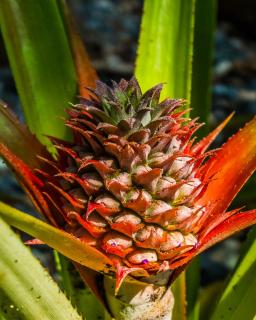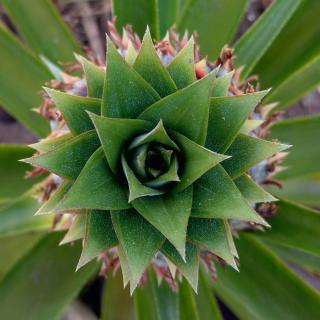

Ananas comosus is a plant that bears beautiful leaves, but what makes the plant famous is its fruit: the pineapple.
Name – Ananas comosus
Family – Bromeliaceae
Type – indoor plant
Height – 12 to 16 inches (30 to 40 cm)
Exposure – very well-lit while avoiding direct sun.
Foliage – evergreen
Flowering – end of winter or summer
Even though the plant is native to Brazil, it’s perfectly possible to grow your pineapple at home if you follow these growing tips.
Read also:
Ananas comosus is a plant that requires soil that is rich and well-drained to grow well. Special Bromeliaceae soil mix seems to be the best solution for your pineapple plant.
 Ananas comosus requires temperatures that hover between 64°F to 75°F (18°C to 24°C) and never drop below 57°F (15°C).
Ananas comosus requires temperatures that hover between 64°F to 75°F (18°C to 24°C) and never drop below 57°F (15°C).
Ananas comosus also requires high moisture levels.
Regular but moderate watering is called for because Ananas comosus doesn’t usually require a lot of water.
Maintain a bit of moisture in the soil mix and provide liquid leaf plant fertilizer every fortnight.
Reduce watering and wait for the soil to be dry before watering again.
Also reduce provision of fertilizer down to once a month.
When grown indoors, most of the common indoor plant diseases may be encountered, such as:
If leaves turn yellow or start looking dull, it means the plant lacks light.
If the tips of leaves droop over, it is because the surrounding air is too dry or too warm. You’ll have to increase moisture around the leafage. Try misting the leaves with soft water.
If the plant doesn’t grow and your pineapple plant remains stunted, it’s probably connected to lack of fertilizer.
 This fruit plant is native to Brazil but is now grown in tropical countries across the planet.
This fruit plant is native to Brazil but is now grown in tropical countries across the planet.
As a plant of the Bromelia family, it only bears a single flower in its lifetime.
With its thick, spiny leaves, it’s a wonderfully graphic plant. It does great in modern settings.
It doesn’t require any pollination to produce its fruit, the delicious pineapple.
You can use the leafy tip of a pineapple to start a new plant! This is a rare case of fruit cuttings that are often very successful.
Watch out for drafts and gusts: the pineapple plant hates those as much as it hates sudden temperature swings.
Read also: